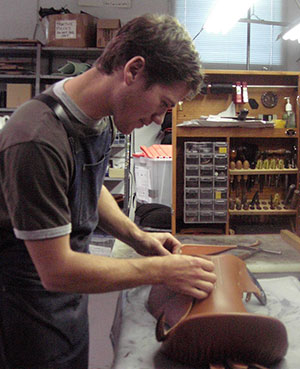
Jochen Schleese (back row) shown here with Master Saddlers John Banbury, Eydie Braant-Vandenberg (our first female apprentice) and Dave Nangreave all of whom received their Master Saddlers’ certification through the Schleese Apprenticeship Programme.
It’s that time of year again when school has begun for students of all ages. From the moment students enter high school, emphasis is placed on achieving high grades to prepare for post-secondary education. The reality is only 18 per cent of students, less than one in five, who enter Grade 9 will go on to study at a post-secondary level. The remaining 82 per cent are often ignored in terms of training programs available and, according to the Ministry of Labour, Ontario’s workforce is realizing the consequences. An almost 20 year old survey predicted that Ontario would soon experience a province wide shortage of skilled labourers in all trades. As the need continues to grow, private industry and even self-employed tradespeople are starting to see the importance of training apprentices to pass their knowledge on to the next generation of workers. Every aspect of our industry needs to get involved in this educational process.
There are many career options open to people who want to be involved somehow in the world of our four-legged friends. What is disconcerting however, is the lack of regulations or controls in this industry. This seems rather paradoxical, given the inherent danger associated with dealing with a huge four-legged animal – in whatever capacity.
Apprenticeship training provides access to well-paying jobs that demand a high level of skill, judgment and creativity. The demand for skilled workers continues to increase, with top performers in some skilled trades earning excellent wages. Many use their skills and experience as stepping-stones toward careers in management, while others go into business for themselves.

Chris Moloughney shown here setting ‘skirts’ on a ‘blocked’ saddle seat during his apprenticeship.
When one mentions apprenticeships, most immediately think of the construction industry, machinists or tool and die making. But one of the less traditional, yet highly lucrative, apprenticeship opportunities can be found in the saddlery trade. The three-year certified saddler course we sent up in 1990 is recognized by the Ministry of Skills Development and its structure was based on ministry guidelines.
We initially couldn’t get good people in North America, so we figured the best way to solve the problem was to train our own. Over the years the focus has changed from the very involved and time-consuming actual saddlery apprenticeship to working with skilled leather craftsmen – all of whom excel at one area of saddle making but only a few of which go on to actually learn how to make saddles from start to finish.
Now through Saddlefit 4 Life we have taken things one step further and are training and certifying equine ergonomists – who can measure and assess saddle fit and make suggestions – as well as saddle ergonomists – who have been trained in equine anatomy, biomechanics, and can actually adjust saddles in tree width and angle and reflock panels to accommodate the constantly changing three-dimensional shape of the horse’s back and saddle support area.

The long-term goal of the program is to encourage young people to get involved in skilled trades and not feel post-secondary education is their only option. Skilled trades are always expanding, the need will never disappear – it will just evolve. The equestrian industry has the opportunity to be at the forefront of this type of job creation, as nowhere else is there such a myriad of different career choices to get involved with – all for the love of the horse.
Email Sabine Schleese for more information at Sabine@saddlefit4life.com.
~ Sabine Schleese, B.Sc., MBA, Saddlefit 4 Life®
